Pandemic and social protests: cities as flashpoints in the COVID-19 era

Cities have been profoundly affected by the many problems caused by the COVID-19 pandemic: deteriorating public health, serious economic recession, deepening social divides, etcetera. These circumstances have become a hotbed of numerous expressions of social unrest which have crystallised in an especially significant way in urban settings.
Hence, new social mobilisations have appeared, channelling the population’s criticisms of the health management of the crisis, or expressing ad hoc demands related with the social and economic problems caused by the pandemic. However, there are other demonstrations too, these being a continuation of pre-existing protests that have intensified as a result of the post-pandemic worsening of material conditions that caused them in the first place.
In this situation of exacerbated social conflict, cities will face, in the short and medium term, highly complex situations that are closely linked with a worsening of urban inequalities. In these circumstances, it will be necessary to hasten to implement public policies designed to mitigate the problems giving rise to these mobilisations. In addition, it will be crucial to devise strategies of urban transformation that will ensure progress towards a just transition to a more equal, sustainable, and democratic society
Since the global financial crisis of 2008, the levels of global protest have been increasing, a trend that has recently intensified owing to the consequences of the COVID-19 pandemic. The appearance of the new pathogen was first recorded in November 2019 in the Chinese city of Wuhan. According to the Johns Hopkins Coronavirus Resource Center, the virus had killed more than five million people worldwide by the end of 2021. Furthermore, 95% of COVID-19 infections and deaths have occurred in cities (UN-Habitat). In this situation, urban governments are under great pressure because of the many problems triggered by the pandemic. These include deterioration in public health, a serious economic recession, deepening of already existing social divides (economic, gender, digital, intergenerational, and so on), and growing distrust of the institutions (Fernández de Losada and Abdullah, 2020).
All these circumstances have become a breeding ground for the appearance of several expressions of social unrest which have crystallised in an especially significant way in urban settings. Some of these manifestations consist of new social mobilisations expressing the population’s dissatisfaction with the health management of the crisis, or new ad hoc demands related with the social and economic problems caused by the pandemic. Others, however, are a continuation of pre-existing protests that have intensified as a result of post-pandemic worsening of the material conditions that caused them in the first place.
Social unrest over the last decade (2011 – 2021), especially that occurring in urban settings, provides an insight into the contextual framework in which social protests of the post-COVID era have erupted. As we shall describe below, this is a backdrop that warns of complex situations that will arise in cities in the short and medium terms as a result of exacerbating inequalities and a concomitant increase in social discord.
Main global trends in social unrest since 2011
According to recent data of the Institute for Economics and Peace, the last decade (2011 – 2021) is notable for increased social unrest. The recession brought about by the global economic crisis of 2008 and the impact of austerity policies led citizens to the streets. As Figure 1 shows, the main expressions of social malaise occurred in 2011 with the wave of protests of the so-called Arab Spring, the Occupy movement, and the Indignados (15-M) movement in Spain. After 2012, these protest movements waned in intensity for different reasons. On the one hand, because they had achieved some of their goals, or because they had been suppressed by government forces. On the other hand, because they dispersed and evolved into other kinds of social movements (organisation of political platforms, social projects, neighbourhood activism, etcetera). A little later, demonstrations and protests increased again to reach a significant peak in 2016 and another in 2018-2019. Cities like Cairo, Beirut, Tunis, Khartoum, and Algiers recorded the highest numbers of protests in these years.
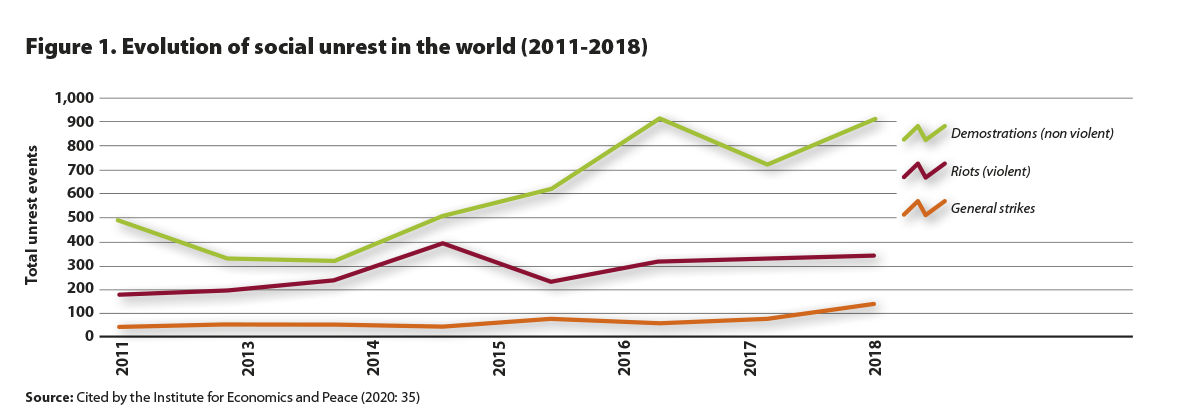
Naturally, not all regions in the world followed the same pattern. Those showing the highest levels of protest between 2011 and 2018 were Europe, Sub-Saharan Africa, and South Asia (see Figure 2) and, whatever the impressions of public opinion, most of these were peaceful (see Figure 1), as was the case in Europe, for example, with 65% of the protests recorded. These mainly happened in Greece (in response to the structural adjustments imposed after the financial crisis), in the United Kingdom (against austerity policies and because of housing problems), in France (the “Yellow Vests”), and in Spain (the Indignados or 15-M movement).
Sub-Saharan Africa, however, experienced the world’s highest levels of violent demonstrations (42.6%). This region saw an exponential increase in protests after 2015, the most affected countries being Nigeria (imprisonment of Ibrahim Zakzaky, leader of the Islamic Movement of Nigeria), South Africa (rising university fees), and Guinea (the broken promise of a teacher’s pay rise and fraud in local elections). In South Asia, the countries showing the greatest social mobilisation were India (general strikes) and Pakistan (anti-government protests), with the biggest upheavals in New Delhi (India), Karachi and Hyderabad (Pakistan), and the border cities of Jammu and Srinagar in Kashmir. As we shall see, both countries have shown the world’s highest levels of unrest since the beginning of the pandemic.
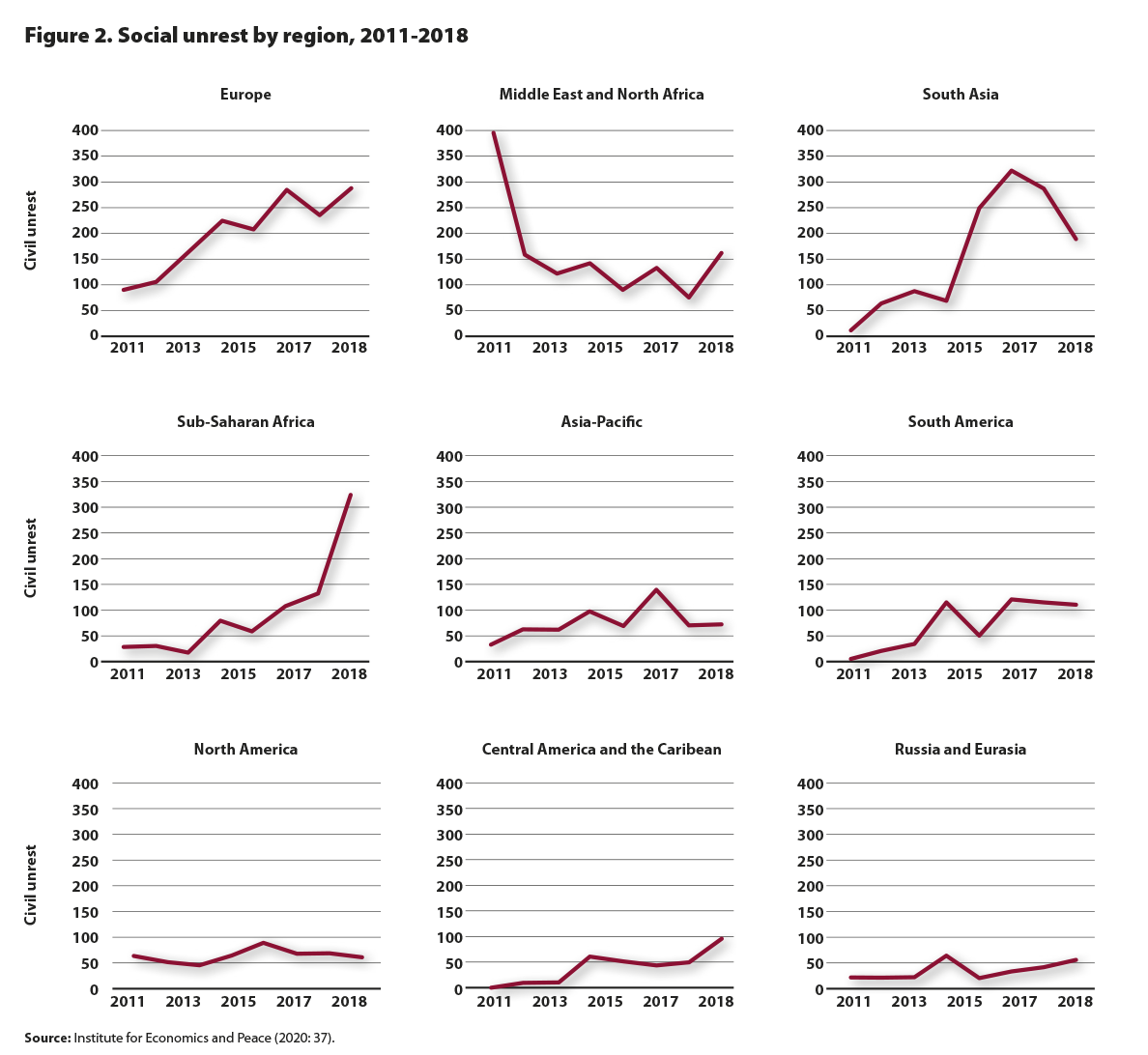
As Figure 2 shows, the regions with the lowest incidence of social unrest from 2011 to 2018 were North America, Central America and the Caribbean, Asia-Pacific, and Russia-Eurasia. Nevertheless, this pattern was disrupted with the outbreak of COVID-19 because, as we shall describe in the next section, these regions concentrated the highest levels of social conflict (Institute for Economics and Peace, 2020: 33). In 2019, the world saw a global increase in protests, with some particularly significant hotspots. Among them, notable examples are the demonstrations of the “Yellow Vests” in France—which had begun at the end of 2018—in Hong Kong against the extradition bill, and in India against the Citizenship Amendment Act. In Latin America, there were protests in Chile, Colombia, and Mexico. In Chile, the population initially demonstrated against public transport fare hikes, but the mobilisations later extended to demands for a new constitution. In Colombia, protestors demonstrated against President Iván Duque and his economic, social, and environmental policies. His handling of the peace agreements with the guerrilla group FARC (Revolutionary Armed Forces of Colombia), coupled with follow-up calls by the National Strike Committee sparked protests in Bogotá, Barranquilla, Medellín, and Cartagena in particular. In Mexico, there were several large feminist protests, with Mexico City leading the way, followed by Morelia and Oaxaca City (ibid).
In the Middle East, there were notable demonstrations in Iran, Iraq, and Algeria. In Iran, rising fuel prices caused social unrest that led to months of anti-government protests. In Iraq and Algeria, mass demonstrations destabilised the countries to such a degree that their leaders had to resign, an especially significant situation in Algeria when President Abdelaziz Bouteflika was forced to step down after twenty years in power. In the Sub-Saharan region, Sudan stood out for demonstrations demanding a democratic transition in the country and eventually culminating in a coup d’état against President Omar al-Bashir. This then led to a more recent public expression of grievance, in October 2021, after an army-led coup caused further huge protests in Khartoum. However, all these social movements came to a complete standstill with the outbreak of the COVID-19 pandemic and the consequent government restrictions on human mobility and social activity in public space.
Social unrest in the COVID-19 era: global trends
The World Health Organization (WHO) declared the global pandemic on 11 March 2020. As can be seen in Figure 3, civil unrest dropped by 30% in the first months of the year although protest rates rose shortly afterwards by 7% in comparison with 2019 (Kishi et al., 2021: 2).
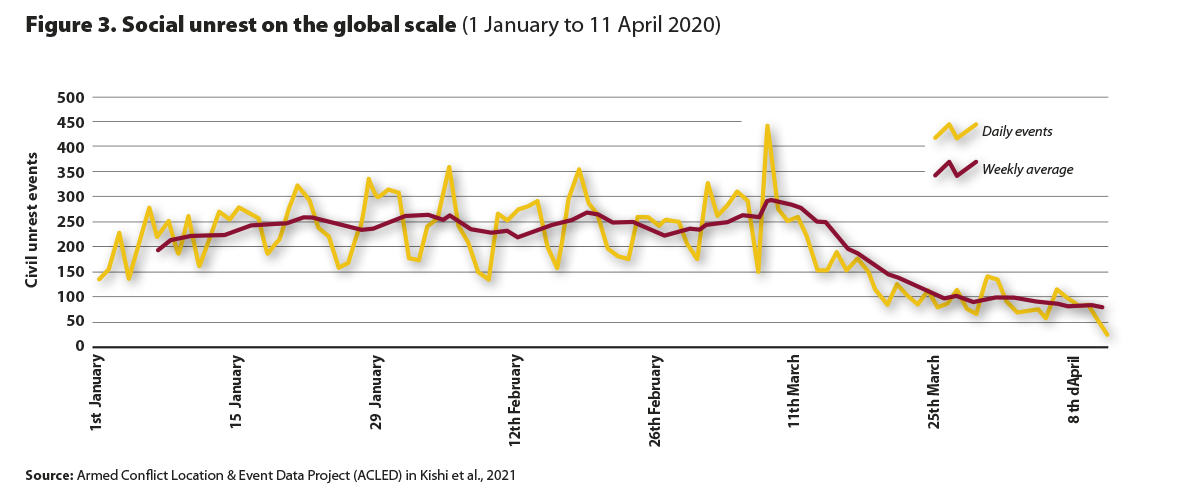
Since then, two main trends have appeared: a) the emergence of new protests directly triggered by COVID-19, and as a public response to health management of the pandemic; and b) intensified pre-pandemic protests due to a worsening of the problems that originally triggered them. Table 1 shows the two trends.
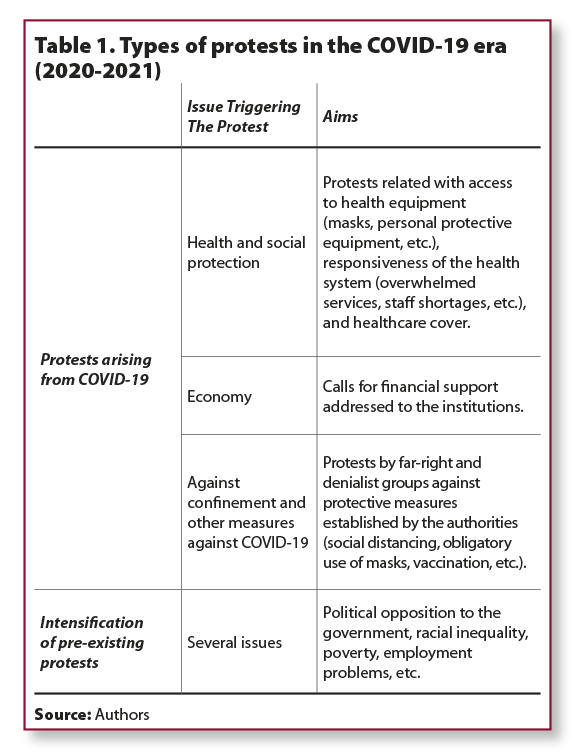
Protests sparked by COVID-19 were the first to spill into the streets, whether they were rejecting restrictions (Germany, United States), calling for better health management of the pandemic (Argentina, Brazil, China, Mexico), or demanding financial support measures (South Korea, Japan). Seoul, New York, and Mexico City have headed the list of cities with the highest numbers of COVID-19 protests (Kishi et al., 2021).
Not long afterwards, the interrupted pre-pandemic protests resumed, now spurred on even more by the impact of the health crisis. In countries like Israel, Iraq, Lebanon, Pakistan, and Tunisia, the pandemic has exacerbated already existing problems related with government corruption or the economic situation. Among the cities affected, Beirut has probably been the hardest hit. Chronic corruption, absence of public services, and legal impediments to the investigation into the explosions in the port of Beirut in August 2020 have led to massive protests in the country. Likewise, in Chile and Peru the pandemic has led to numerous workers’ demonstrations. Following calls by the National Strike Committee, Colombia has also seen mass protests which were aggravated by police violence in Cali. There, many organisations and demonstrators were victims of excessive use of force. In Argentina, the climate of discord over the abortion law has been inflamed by mass criticism of the government’s health management and the negative impact of the crisis on the country’s economy. Something similar has occurred in Serbia where there has been considerable unrest over alleged electoral fraud. Neither has the pandemic averted protests against the Lukashenko government in Belarus. As for the violent or peaceful nature of these expressions of disaffection, approximately 93% were peaceful. Nevertheless 16% have been subject to police crackdowns, especially in Belarus (ibid.: 22-23).
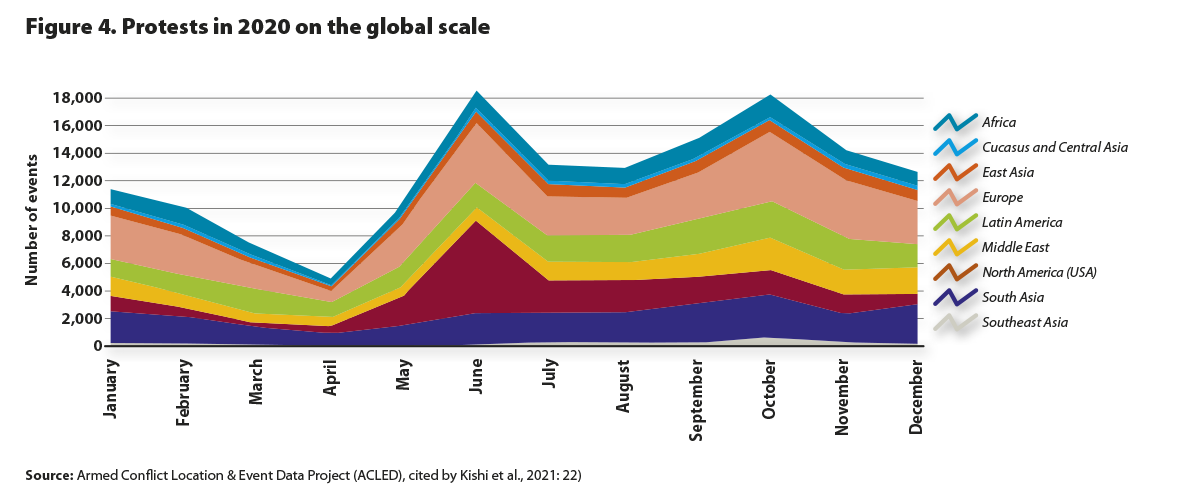
n this situation of a global increase in protests, the exception is Asia where the region as a whole shows fewer incidents of unrest. However, and contrary to the regional pattern, it is also the continent with two countries with the greatest number of protests in 2020, India and Pakistan. Yet, on the global scale, the country that recorded the largest number of manifestations of social unrest was the United States which had almost as many demonstrations as India and Pakistan combined, as Figure 5 reveals.
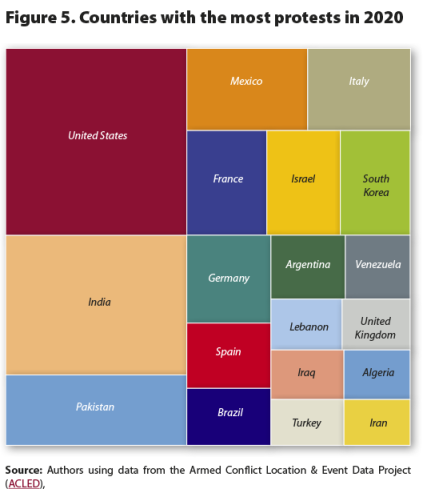
The cities in the United States that were most affected by expressions of social unrest in the COVID-19 era (according to data from February 2020 to June 2021) are New York (1,054 protests), Portland (459), and Los Angeles (428). It is not surprising that New York should head the list since it is the country’s most populated city with more than 8.5 million inhabitants. However, why Portland, with just over half a million inhabitants, should come second on the list, ahead of Los Angeles, would not seem to be so obvious. Portland has a level of social unrest comparable to that of Paris, which has four times its population. This can be explained by the protests that occurred after the murder of George Floyd in May 2020. Although Portland’s African American Population accounts for little more than 5% of the whole, the city has a highly organised anti-racist movement and a decades-long tradition of social mobilisation (the Occupy movement, feminist struggles, anti-Trump collectives, etcetera), which gives some inkling of why there have been so many expressions of social unrest.
As can be seen, cities are an optimal place for expression of social protests. To a large extent, in present circumstances, this is because they are also places where the pandemic has had the greatest social, economic, and political impact.
COVID-19, an urban pandemic that aggravates inequalities
United Nations data on the incidence of COVID-19 at the global level reveal that this is essentially an urban pandemic. Approximately 95% of infections and deaths have occurred in cities (affecting some 1,500 urban centres). Indeed, the pandemic-city link is not new as there is a historical relationship between cities and epidemics which somehow explains urban development in the last two centuries. Urban spaces are dense networks with high concentrations of people living and working together. Subsequently, they have constituted an ideal breeding ground for outbreaks of plagues and epidemics. Each serious public health crisis has prompted a revision of the urban model aiming to ensure the necessary hygiene and sanitary conditions in cities. The early attempts to provide secure urban spaces ranged from engineering works that provided access to potable water, waste management and sewage systems, through to the construction of parks, promenades, and public squares. From the 1918 flu pandemic to that of swine flu in 2009 (both caused by the H1N1 virus), cities have been laboratories for testing public health solutions. Hence, it can be argued that the city, as we know it today, has been shaped to a considerable extent by the impact of infectious diseases.
According to forecasts (Martínez and Rennie-Short, 2021: 2), this link between pandemic and city will become more pronounced in the future. The dynamics of global urbanisation involve changes in land use and destruction of natural ecosystems. The transformation of wilderness areas into peri-urban agricultural land is increasing the numbers of disease-carrying animals (like rats, mosquitos, and bats) entering urban environments. In these circumstances, cities surrounded by agricultural land are more prone to outbreaks of infectious diseases since studies show that more than 60% of these pathogens come from wild animals. This situation is compounded by high levels of global connectedness and, consequently, swift propagation of diseases on the planetary scale.
In fact, it is in urban environments where COVID-19 has drawn attention to and aggravated many structural vulnerabilities - especially those related with fragile public health systems, precarious housing and employment, as well as lack of infrastructure providing clean drinking water and basic sanitation in some geographical settings. With these underlying problems, having a guaranteed right to health has not always been an attainable goal for some people. Contrary to what was said in the early days of the pandemic—that the “virus affects everyone equally”—its repercussions have been much more serious in some population groups, as is argued by doctors from several British universities who published a letter to the editor in the journal Public Health titled “Poverty, inequality and COVID-19: the forgotten vulnerable” in which they point out that people of low socioeconomic status are more vulnerable to COVID-19 for several reasons: a) they are more likely to be living in overcrowded conditions in poor housing (ill-ventilated, with little access to outside space); b) they are employed in occupations that do not allow work from home, which means that it is difficult for them to reduce their mobility; c) their working conditions and incomes are more unstable, factors that harm mental health and also weaken the immune system; d) they go to healthcare services at more advanced stages of health problems; e) they have to face several situations (linguistic barriers, discrimination, disrespectful treatment, etcetera) which make them feel less comfortable about going to health centres; and f) they tend to suffer from more problems of hypertension and diabetes, both of which are COVID-19 risk factors.
It would therefore appear that there is a clear link between inequalities and greater vulnerability in the pandemic. The first studies appearing in the United States demonstrate that this is indeed the case: the death rate among African Americans is 3.5 times higher than that for the white population. In April 2020, for example, 70% of deaths caused by COVID-19 in Chicago were among the Black population, which represents only 29% of the total. Moreover, this pattern is closely linked with territorial disparities, which account for the different rates of infection among neighbourhoods of the same city. The pre-pandemic problems of residential segregation, restricted access to basic services, and limited availability of decent housing in some zones of the city explain the higher incidence and mortality of the virus in poor neighbourhoods where most of the more vulnerable groups are concentrated.
Yet, for all the empirical evidence, measures combatting the virus have overlooked the unequal cartography of the pandemic’s impact. This has meant that decisions taken from the macro standpoint have ended up compounding problems at the micro level (Díaz, Palacio, 2021). There can be no doubt that the pandemic has worsened inequalities and, according to forecasts by international organisms, they will deepen even more in the coming years. In this regard, the World Bank estimates that middle-income countries will be particularly affected by the emergence of a surge of “new poor” resulting from COVID-19. This new group will mainly be found in cities and urban areas.
The International Monetary Fund (IMF) also predicts an increase in social problems and, in particular, has warned of greater social unrest after March 2022. According to the IMF, protests arising from pandemics escalate fourteen months after the outbreak and, if appropriate measures are not adopted, they reach a peak after the twenty-fourth month (Sedik and Xu, 2020: 5).
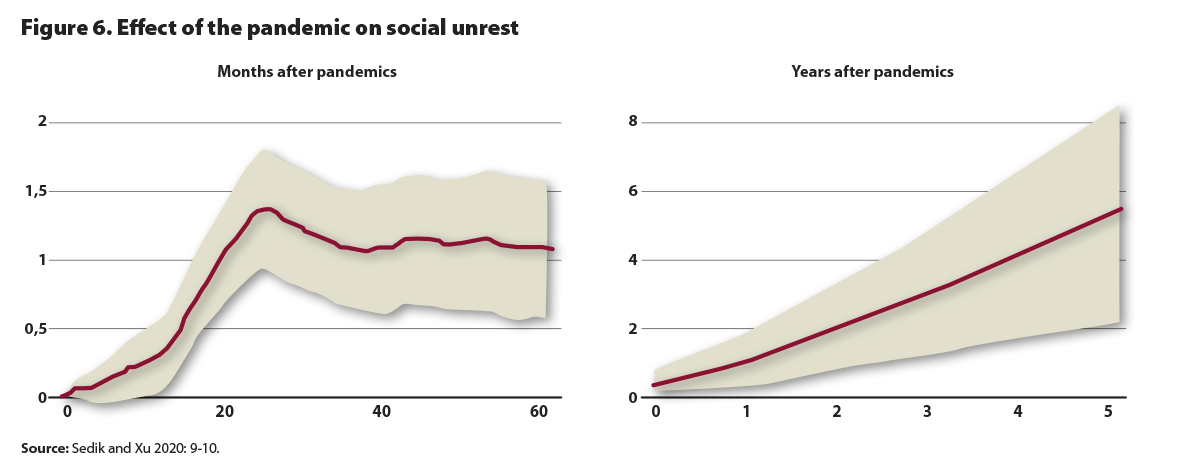
2022, the year of urban protests
Unless urgent measures are taken, the post-pandemic era will see an increase in social protests as a result of widening inequalities and worsening of people’s living conditions. These problems will manifest severely in cities, which could face extremely complicated situations in the coming months owing to surges of social unrest. In view of this prediction, on which several international organisations agree, immediate implementation of public policies is required to attempt to mitigate the problems that will fuel these mobilisations. Similarly, it will be essential to design strategies of post-pandemic transformation that will provide the underpinning of a just transition towards a more equal, sustainable, and democratic model of the city.
We are at a pivotal point in history. The extent to which policy makers are aware of this is moot. Yet it is up to them to adopt the necessary policies and measures to avoid social upheavals that could destabilise the road to post COVID-19 recovery and transformation.
References
Díaz, Fabio y Palacio, María Gabriela. “Inequality and the Socioeconomic Dimensions of Mobility in Protests: The Cases of Quito and Santiago”. Global Policy, Vol. 12, Nº 52 (April 2021), pp. 78-90.
Fernández de Losada, Agustí and Abdullah, Hannah. “Cities on the frontline: Managing the Coronavirus crisis”. CIDOB Report, Nº 5 (2020) (online) https://www.cidob.org/en/publications/publication_series/cidob_report/cidob_report/cities_on_the_frontline_managing_the_coronavirus_crisis.
Institute for Economics and Peace. Global Peace Index 2020: Measuring Peace in a Complex World (June 2020) (online) http://visionofhumanity.org/reports.
Kishi, Roudabeh; Pavlik, Melissa; Bynum, Elliott; Miller, Adam; Goos, Curtis; Satre, Josh, andy Jones, Sam.“ACLED 2020: The Year in Review” (March 2021) (online) https://acleddata.com/2021/03/18/acled-2020-the-year-in-review/
Martínez, Lina and Short, John Rennie. “The Pandemic City: Urban Issues in the Time of COVID-19”, Sustainability, Vol. 13, Nº 6 (2021), p. 3295 (online) https://doi.org/10.3390/su13063295
Sedik, Tahsin Saadi and Xu, Rui. “A Vicious Cycle: How Pandemics Lead to Economic Despair and Social Unrest”. IMF Working Paper, Nº 216 (October 2020) (online) https://www.imf.org/en/Publications/WP/Issues/2020/10/16/A-Vicious-Cycle-How-Pandemics-Lead-to-Economic-Despair-and-Social-Unrest-49806
DOI: https://doi.org/10.24241/NotesInt.2022/266/en
E-ISSN: 2013-4428